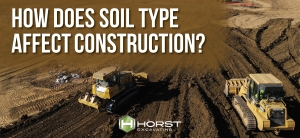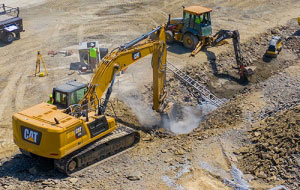How Does Soil Type Affect Construction?

Not all dirt is created equal. From dense clay to soft sand, the type of soil that makes up your site can have a big impact on how and what you’re able to build. Understanding your site’s soil composition and the work required to prepare it for construction is key to your project’s success.
In the 60+ years we’ve been excavating, we’ve seen a wide variety of soil types on site. In this blog, we’ll share some insights into each of the six most common soil types, so you’ll be ready to start building no matter what your site is like.
Clay
Clay is made from very small and old soil particles tightly compacted from environmental pressures over many years. While fairly common across the United States and the world, a few considerations should be taken before building on clay.
Because it’s a mixture of very small particles, clay retains moisture for a significant amount of time. When clay gets wet, it expands. But as it dries, it shrinks significantly. This expansion and contraction can put a great deal of strain on building foundations, which can lead to shifting, moving, and cracks. To avoid damage and costly repairs, buildings constructed on clay-filled sites need the proper approach.
There are three common methods to create a long-lasting foundation in clay.
1. Dig Deep & Protect the Sides
Most of the swelling and shrinking of clay happens in the first few feet of soil. In some cases, your team can dig past this layer and rest the foundation on the more stable soil below. To avoid that lateral pressure on the portion that does pass through clay, contractors can create trenches and line them with a slip membrane. This layer absorbs pressure from the shifting clay, protecting the foundation within.
2. Build Wide & Reinforce
Creating a wider foundation spreads the pressure of the swelling and shrinking clay over a larger area, reducing its impact and the likelihood of any damage. Steel enforcements can enhance the foundation’s strength as well.
3. Stabilize the Soil
Clay soil can be stabilized by mixing a non-toxic solution into the earth, such as quick lime or cement. This impairs the soil’s ability to hold water, reducing the swelling and shrinking of the soil.
Soil ID Tip: Clay will be very slippery and pliable when wet. When dry, it will crumble in your hands.
Loam
Loam, a combination of clay, sand, and silt, is often regarded as one of the best soils for building. It absorbs water and dries out at a steady rate. There’s much less expansion and contraction with loam than with clay. This means less pressure is exerted on the foundation.
While loam is great for building on, it’s typically best to do some soil conditioning before jumping in on the foundation. You’ll want to ensure there’s nothing below ground that will shift over time. Typically, this consists of removing uncompressed soil components (like vegetation, tree stumps, and roots, etc.). If left in the earth, the ground around these items can shift as they decompose. These shifts can cause issues with nearby building components.
Soil ID Tip: Loam is usually dark in color. If you scoop up a handful, it should feel soft and dry, and crumble in your hands (unless it recently rained).
Peat
Peat is great for scotch, gardening, and storing carbon—but not for construction.
It consists of partially decomposed organic matter (mostly vegetation) and is typically found in wetlands. This acidic and extremely porous material holds a great deal of water, and in doing so, expands a good amount when wet. However, when things get dry, it quickly shrinks.
Because peat changes so dramatically with the weather, it’s less than ideal for supporting a foundation. It has a low bearing capacity and the swelling and shrinking will put strain on and cause the shifting of the foundation. Peat is not very common in the United States, but there are some areas in the north where you may run into peat bogs.
Some companies are experimenting with different ways to build on peat, like this Scottish research group. If the peat layer is shallow, you may be able to remove it and replace it with more suitable soil. If the foundation below is firm, you may also be able to use concrete piles to support the building. If not, in some situations a raft foundation could work. All that said, if you have the option, it’s best to avoid building on peat.
Soil ID Tip: Peat soil will feel spongey and look very dark.
Rock

However, the foundation must be flat and level to properly support the building. Achieving this can require a good deal of materials and labor. Depending on how far the rock is from the surface, significant excavation of soil may be required before work on the foundation begins, especially if you’re planning on building on bedrock.
In some instances, rocks may need to be removed from the site to make way for more suitable fill material or building components. To learn more about encountering rocks on a construction site, check out our blog.
Soil ID Tip: If rock lies right on the surface of your site, it doesn’t get much easier. However, if it’s located below organic matter, you may need to talk to a professional.
Sand & Gravel
Compared to clay and silt, sand and gravel are composed of much larger particles. This means water drains quickly and the issues relating to the swelling, shrinking, and shifting of soil are avoided.
Before building on sand and gravel, most contractors will prefer to compact the soil to ensure it’s as stable as possible. They may also opt to install helical piers or anchors to protect the foundation in the event of water washing away the sand. These piers are driven deep into the soil, below where even heavy rains would cause a washout.
Soil ID Tip: You’ll be able to feel the sandy soil’s grittiness when you pick up a handful. It should also fall through your fingers and can’t be rolled together in a ball.
Silt
Silt is similar to clay, but the particulates that make it up are even smaller and finer. It retains large amounts of water for a long time. As it dries out, it shrinks down. This expansion and contraction can cause issues if a building’s foundation rests within it. Whenever possible, it’s best to avoid building in silty soils.
Soil ID Tip: Silty soil will feel very smooth and muddy while it’s wet and can easily be shaped into a ball. Unlike clay, it won’t be sticky. When it’s dry, it should feel very soft and powdery.
What Type of Soil Should You Build On?
Soil type is just one component of choosing a site for your next building project. Everything from size to location to zoning will have sway over your decision. The best thing you can do is to partner with experienced engineering and design professionals who are familiar with the area and its soils. Equally as important is bringing on an experienced excavating and sitework firm that knows how to work that soil and create a solid base for the rest of your project.
At Horst Excavating, we like to get involved in the project early on, so we can work collaboratively with the project team from the start. Tell us about your next project today!
Posted January 18, 2023

